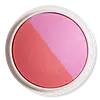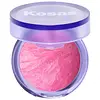What's inside
What's inside
 Key Ingredients
Key Ingredients

 Benefits
Benefits

 Concerns
Concerns

 Ingredients Side-by-side
Ingredients Side-by-side

Water
Skin ConditioningMica
Cosmetic ColorantSynthetic Fluorphlogopite
Zea Mays Starch
AbsorbentTriisostearin
Skin ConditioningBoron Nitride
AbsorbentOctyldodecanol
EmollientMacadamia Ternifolia Seed Oil
EmollientSimmondsia Chinensis Seed Oil
EmollientHelianthus Annuus Seed Oil
EmollientLimnanthes Alba Seed Oil
Skin ConditioningHibiscus Sabdariffa Flower Extract
Skin ConditioningHydrolyzed Sodium Hyaluronate
Skin ConditioningTriethoxycaprylylsilane
Ethylhexylglycerin
Skin ConditioningXanthan Gum
Emulsifying1,2-Hexanediol
Skin ConditioningCaprylyl Glycol
EmollientLauroyl Lysine
Skin ConditioningTin Oxide
AbrasiveAluminum Hydroxide
EmollientKaolin
AbrasiveTocopherol
AntioxidantGlyceryl Behenate
EmollientCI 77891
Cosmetic ColorantCI 77491
Cosmetic ColorantCI 77492
Cosmetic ColorantCI 15850
Cosmetic ColorantCI 77007
Cosmetic ColorantWater, Mica, Synthetic Fluorphlogopite, Zea Mays Starch, Triisostearin, Boron Nitride, Octyldodecanol, Macadamia Ternifolia Seed Oil, Simmondsia Chinensis Seed Oil, Helianthus Annuus Seed Oil, Limnanthes Alba Seed Oil, Hibiscus Sabdariffa Flower Extract, Hydrolyzed Sodium Hyaluronate, Triethoxycaprylylsilane, Ethylhexylglycerin, Xanthan Gum, 1,2-Hexanediol, Caprylyl Glycol, Lauroyl Lysine, Tin Oxide, Aluminum Hydroxide, Kaolin, Tocopherol, Glyceryl Behenate, CI 77891, CI 77491, CI 77492, CI 15850, CI 77007
Mica
Cosmetic ColorantSilica
AbrasiveCapryloyl Glycerin/Sebacic Acid Copolymer
Skin ConditioningLauroyl Lysine
Skin ConditioningGlyceryl Stearate
EmollientOctyldodecanol
EmollientSimmondsia Chinensis Seed Oil
EmollientPentylene Glycol
Skin ConditioningGlycerin
HumectantGlyceryl Caprylate
EmollientPotassium Sorbate
PreservativeBambusa Arundinacea Stem Powder
AbrasivePassiflora Edulis Seed Oil
EmollientGlyceryl Undecylenate
EmollientWater
Skin ConditioningStearic Acid
CleansingCandelilla Cera
EmollientXanthan Gum
EmulsifyingSodium Phytate
Cetearyl Olivate
Tocopherol
AntioxidantSorbitan Olivate
EmulsifyingHonokiol
AntioxidantPaeonia Officinalis Flower Extract
TonicHelianthus Annuus Seed Oil
EmollientVitis Vinifera Seed Extract
AntimicrobialCI 77891
Cosmetic ColorantCI 77491
Cosmetic ColorantCI 77492
Cosmetic ColorantCI 77499
Cosmetic ColorantMica, Silica, Capryloyl Glycerin/Sebacic Acid Copolymer, Lauroyl Lysine, Glyceryl Stearate, Octyldodecanol, Simmondsia Chinensis Seed Oil, Pentylene Glycol, Glycerin, Glyceryl Caprylate, Potassium Sorbate, Bambusa Arundinacea Stem Powder, Passiflora Edulis Seed Oil, Glyceryl Undecylenate, Water, Stearic Acid, Candelilla Cera, Xanthan Gum, Sodium Phytate, Cetearyl Olivate, Tocopherol, Sorbitan Olivate, Honokiol, Paeonia Officinalis Flower Extract, Helianthus Annuus Seed Oil, Vitis Vinifera Seed Extract, CI 77891, CI 77491, CI 77492, CI 77499
Ingredients Explained
These ingredients are found in both products.
Ingredients higher up in an ingredient list are typically present in a larger amount.
Ci 77491 is also hydrated iron III oxide. It's sole purpose is to give a red/pink hue to products.
Iron III oxides are classified as inorganic chemicals for coloring.
Synthetically created Ci 77491 is considered safer than those naturally found. This is because the synthetically created version may contain less impurities. Iron oxides are generally non-toxic and non-allergenic.
Learn more about CI 77491Ci 77492 is also hydrated iron III oxide. It's sole purpose is to give a yellow hue to products.
Iron III oxides are classified as inorganic chemicals for coloring.
Synthetically created Ci 77492 is considered safer than those naturally found. This is because the synthetically created version may contain less impurities. Iron oxides are generally non-toxic and non-allergenic.
Learn more about CI 77492Ci 77891 is a white pigment from Titanium dioxide. It is naturally found in minerals such as rutile and ilmenite.
It's main function is to add a white color to cosmetics. It can also be mixed with other colors to create different shades.
Ci 77891 is commonly found in sunscreens due to its ability to block UV rays.
Learn more about CI 77891Helianthus Annuus Seed Oil is the oil derived from the seeds of a Sunflower. Sunflower seed oil is non-fragrant. It is an emollient, meaning it helps to soften the skin.
Sunflower seed oil contains many fatty acids. The fatty acids found in sunflower seeds include (from highest amount to least): linoleic acid, myristic acid, palmitic acid, stearic acid, arachidic acid, oleic acid, and linolenic acid.
These fatty acids help the skin create ceramides. Ceramides play a role in repairing the skin barrier.
Helianthus Annuus Seed Oil helps moisturize the skin. This in turn helps the skin look more rejuvenated and smoother.
Sunflowers are rich in vitamin E.
Historians believe Indigenous cultures of North America domesticated sunflowers before corn. Thus they relied on sunflower oil for a variety of uses. One such use is moisturizing skin and hair.
Sunflower seed oil may not be fungal acne safe. We recommend speaking with a professional if you have any concerns.
Learn more about Helianthus Annuus Seed OilThis ingredient comes from a fatty acid (lauric acid) and amino acid (lysine). It is used to add a silky feel to cosmetics.
According to a manufacturer, its fatty acid base leaves a silky feeling on the skin. It also has emollient properties because of this. Emollients help soften skin by preventing water from evaporating.
Lauroyl lysine is barely soluble in water.
Learn more about Lauroyl LysineMica is a naturally occurring mineral used to add shimmer and color in cosmetics. It can also help improve the texture of a product or give it an opaque, white/silver color.
Serecite is the name for very fine but ragged grains of mica.
This ingredient is often coated with metal oxides like titanium dioxide. Trace amounts of heavy metals may be found in mica, but these metals are not harmful in our personal products.
Mica has been used since prehistoric times throughout the world. Ancient Egyptian, Indian, Greek, Roman, Aztec, and Chinese civilizations have used mica.
Learn more about MicaOctyldodecanol is a fatty alcohol. It is primarily used to enhance the texture of products.
As an emulsifier, Octyldodecanol helps prevent the oils and waters from separating. It also prevents ingredients from creating foam when shaken.
Octyldodecanol is created by reducing fatty acid to an alcohol.
Due to its high molecular weight, it does not get absorbed into the skin.
Learn more about OctyldodecanolThis oil comes from the seeds of the desert shrub called Jojoba. It is more commonly known as jojoba oil, a non-comedogenic oil.
Jojoba oil does not contain fragrance and has many fatty-acids, making it a great soothing ingredient.
It also contains Vitamin E, a great moisturizing ingredient. Vitamin E is also an antioxidant and protects your skin against oxidative damage.
This ingredient humectant properties, meaning it helps draw moisture from the air. This helps keep your skin hydrated.
While jojoba has antibacterial properties, it is only able to kill some strains of bacteria.
Studies also show it helps in wound healing. In fact, Indigenous cultures have used jojoba as a moisturizer and to help treat burns for centuries.
Fun fact: Jojoba oil similar to natural human skin sebum, so it has a great effect on dry skin. It is also promising with helping to regulate sebum production.
Due to its fatty acid content, Jojoba oil may not be fungal acne safe. We recommend speaking with a professional if you have any concerns.
Learn more about Simmondsia Chinensis Seed OilTocopherol (also known as Vitamin E) is a common antioxidant used to help protect the skin from free-radicals and strengthen the skin barrier. It's also fat soluble - this means our skin is great at absorbing it.
Vitamin E also helps keep your natural skin lipids healthy. Your lipid skin barrier naturally consists of lipids, ceramides, and fatty acids. Vitamin E offers extra protection for your skin’s lipid barrier, keeping your skin healthy and nourished.
Another benefit is a bit of UV protection. Vitamin E helps reduce the damage caused by UVB rays. (It should not replace your sunscreen). Combining it with Vitamin C can decrease sunburned cells and hyperpigmentation after UV exposure.
You might have noticed Vitamin E + C often paired together. This is because it is great at stabilizing Vitamin C. Using the two together helps increase the effectiveness of both ingredients.
There are often claims that Vitamin E can reduce/prevent scarring, but these claims haven't been confirmed by scientific research.
Learn more about TocopherolWater. It's the most common cosmetic ingredient of all. You'll usually see it at the top of ingredient lists, meaning that it makes up the largest part of the product.
So why is it so popular? Water most often acts as a solvent - this means that it helps dissolve other ingredients into the formulation.
You'll also recognize water as that liquid we all need to stay alive. If you see this, drink a glass of water. Stay hydrated!
Learn more about WaterXanthan gum is used as a stabilizer and thickener within cosmetic products. It helps give products a sticky, thick feeling - preventing them from being too runny.
On the technical side of things, xanthan gum is a polysaccharide - a combination consisting of multiple sugar molecules bonded together.
Xanthan gum is a pretty common and great ingredient. It is a natural, non-toxic, non-irritating ingredient that is also commonly used in food products.
Learn more about Xanthan Gum